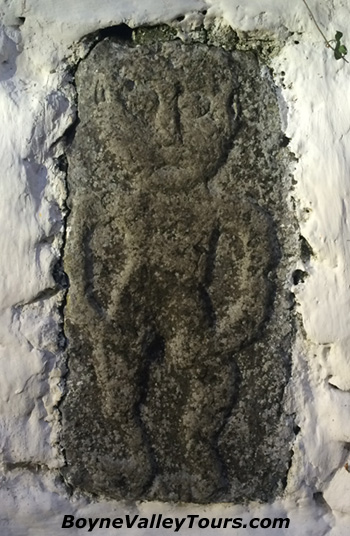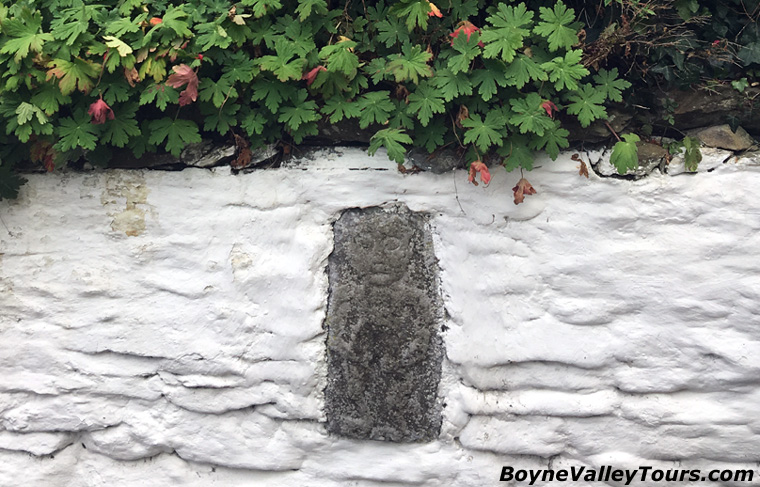Sheela na Gig
|
This Sheela-na-gig is located on private property, and currently, there is no public access.
|
 A Sheela na Gig is a carving of a naked women displaying her vulva.
There are over 100 stone carvings of Sheela na Gigs found on churches, castles and other buildings throughout Ireland.
A Sheela na Gig is a carving of a naked women displaying her vulva.
There are over 100 stone carvings of Sheela na Gigs found on churches, castles and other buildings throughout Ireland.
There are a number of theories about their origin and purpose. They may be pre-Christian fertility symbols or the representation of a mother goddess. Since Sheela na Gigs are mostly found on medieval buildings maybe they originated in that period, either as a warning against lust or a protection against evil.
The Balgeeth Sheela na Gig is located near a Garden Labyrinth and the megalithic passage tomb at Fourknocks.
The term 'Sheela na Gig' was first published in the Proceedings of the Royal Irish Academy 1840–44, as a local name for a carving once present on a church gable wall in Rochestown, Co. Tipperary. The name was also used in 1840 by the Ordnance Survey of Ireland, referring to a figure on Kiltinan Castle, Co. Tipperary.
Balgeeth Sheela-na-gig
The grey, black-specked Sheela is set into a low, hedgerow-topped stone wall at the entrance to a private farmhouse and dairy farm. For several hundred years or more (nobody knows how long), the carving was hidden inside a gatepost and forgotten. But not too long ago a milk collection truck ran into the gatepost, and the long-hidden Sheela was revealed. She was reinstated, face-side out, mortared into the white-washed stone wall to the right of the driveway. The carving is 20 cm (8 in) by 38 cm (15 in). The figure has a large round head, big egg-shaped eyes, a sweet smile, and no neck. Her skeletal arms end in hands that hold open her vulva. She has long thin legs with feet pointing to her right.Sheela-na-gigs are stylized carvings of naked, often skeletal women, clutching their vulvas. There is much disagreement about the origins and significance of Sheela-na-gigs. Some claim they are pre-Christian fertility symbols; others claim the so-called "exhibitionist" figures are Christian representations of lust. They occur in European churches built after the twelfth century (or sometimes earlier) and occasionally in secular buildings as well, often above a window or high up on a wall. In recent centuries they have often been defaced, hidden or destroyed.

The name Sheela-na-gig is from the Irish language, but the exact meaning is uncertain. According to Jack Robert's annotated map, "It is often rendered in Irish as Síle na gCioch. Sheela or Síle means femininity but it also means a special kind if woman, a hag or spiritual woman and also related to the word for a spirit or fairy in Irish, the sidhe (pronounced shee)."
According to Jack Roberts, one of many researchers on the topic, Celtic gods and goddesses were often depicted as ugly to appear more impressive and other-worldly. He also suggests that a skeletal female image that focuses on the vulva, rather than on a full belly and breasts, is likely to symbolize death, life, and regeneration. Nora Judge told us that Irish midwives carry them as good-luck talismans. Interestingly, some of the Sheela figures are known in local folklore by the names of particular saints.
Fertility symbol? Good luck talisman? Apotropaic images meant to "turn away the evil eye"? A warning against lust? A reminder of the perils of sexuality? A celebration of the goddess? We leave it to you to decide. The Sheela-na-gig is indeed a powerful symbol
|
This Sheela-na-gig is located on private property, and currently, there is no public access.
|
Boyne Valley Tours Privacy, Terms and Conditions
Home
| Private Driver Tour
| Cruise Excursion
| Places
| Ireland's Ancient East
| About Us
| FAQs
| Contact
| Newgrange
| Knowth
| Hill of Tara
| Monasterboice
| Trim Castle
| Mellifont Abbey
| Slane
